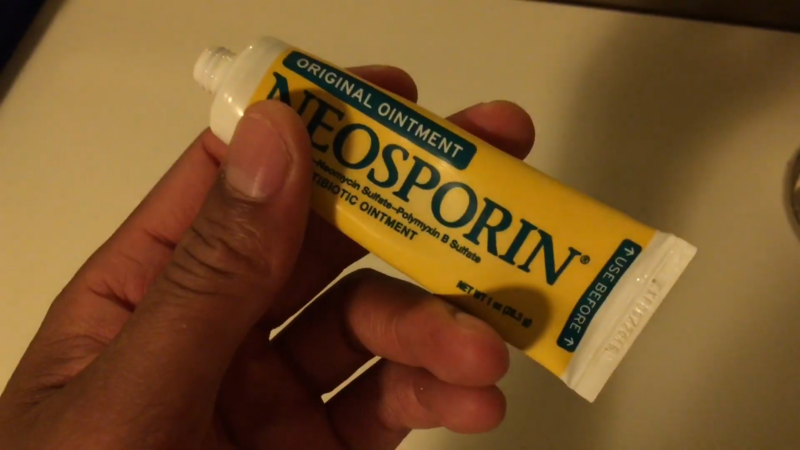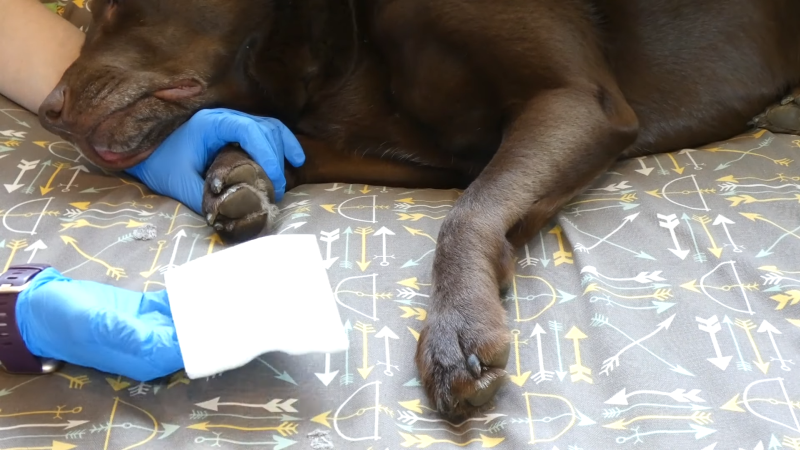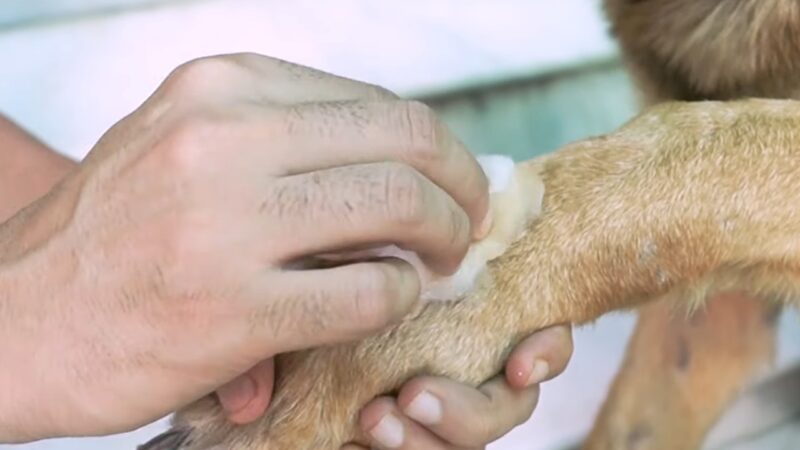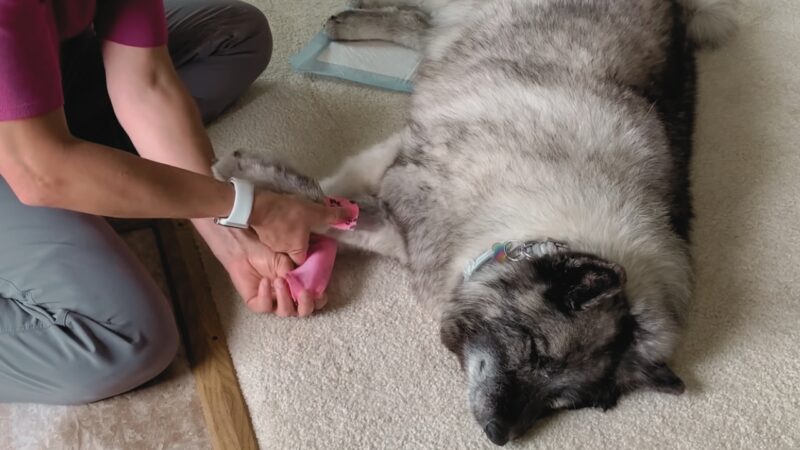When our furry friends get a little too adventurous and end up with cuts or scrapes, our first instinct is to reach for something that can help them heal quickly.
Neosporin, a staple in many human first-aid kits, often comes to mind. But is it safe to use on dogs? Let’s find out.
Key Takeaways
- Neosporin is generally safe for minor wounds on dogs, but vet consultation is advised before use.
- Watch for allergic reactions and prevent your dog from ingesting Neosporin, as it can cause gastrointestinal issues.
- Alternatives designed specifically for pets are available and might be safer options.
- Immediate veterinary care is necessary for deep wounds, signs of infection, or if a dog ingests a large amount of Neosporin.
What Exactly Is Neosporin?

Neosporin is a popular ointment used by humans to prevent infections in minor cuts, burns, and scrapes. Its magic lies in its three active ingredients: bacitracin, neomycin, and polymyxin B.
These ingredients work together to keep wounds clean and free from bacteria. However, it’s important to note that the manufacturers of Neosporin do not recommend its use on animals.
Can You Use It on Your Dog?
In short, Neosporin can be used on dogs for minor wounds, but there are a few things you should consider first. Always talk to your vet before applying any human medication to your pet.
While Neosporin is generally safe for dogs, there are potential risks, especially if your dog decides the ointment is a tasty snack.
Possible Side Effects
- Allergic Reactions: Some dogs might react badly to Neosporin, showing signs of redness, hives, or itching. Though rare, severe reactions can occur, including difficulty breathing and swelling of the face.
- Ingestion Issues: If a dog licks the wound area and ingests Neosporin, it could lead to stomach upset, vomiting, diarrhea, and a loss of appetite.
Basic Wound Care for Dogs
If your dog gets a minor cut or scrape, here’s a simple guide to follow:
- Apply pressure to stop any bleeding.
- Rinse the wound gently with water.
- Clean the area with an antibacterial cleanser suitable for pets.
- Keep an eye on the wound for any signs of infection.
Alternatives to Neosporin

Given the potential risks associated with Neosporin, you might wonder about safer alternatives. Fortunately, there are products specifically designed for pets, including wound care ointments and medicated wipes.
These are formulated to minimize the risk of allergic reactions and are less likely to cause issues if ingested.
When to See a Vet
- Severe Wounds: If the wound is deep, keeps bleeding, or shows signs of infection, it’s time to visit the vet.
- Ingestion of Large Amounts: Neosporin can upset your dog’s stomach if ingested in significant quantities. If you suspect your dog has eaten a lot of it, seek veterinary care immediately.
Neosporin’s Ingredients and Their Effects
- Bacitracin, Neomycin, and Polymyxin B: These ingredients are effective against bacteria but can cause stomach upset if ingested.
- Neomycin and Hearing Loss: There’s a link between neomycin and hearing loss in dogs, particularly with intravenous use. While topical application is less risky, consulting with a vet is crucial.
- Gastrointestinal Upset: Ingesting Neosporin can disrupt the delicate balance of your dog’s gastrointestinal flora, leading to upset.
Performing a Patch Test
Before applying Neosporin, it’s wise to perform a patch test. Apply a small amount to an unaffected area and monitor for any adverse reactions, such as redness or itching.
The Risks and Precautions

When considering the application of Neosporin on your dog’s minor wounds, it’s not just about the immediate effects but also understanding the long-term implications and taking the necessary precautions to ensure their safety and well-being.
Why Consultation with a Vet is Key
Consulting with a veterinarian before applying Neosporin or any human medication to your dog cannot be overstated.
Vets can provide tailored advice based on the specific needs and health conditions of your pet, ensuring that the treatment will not cause more harm than good.
They can also suggest pet-specific alternatives that might be safer and more effective.
The Importance of Monitoring
After applying a small amount of Neosporin to a minor wound, close monitoring is crucial. Watch for any signs of adverse reactions, such as increased redness, swelling, or discomfort.
Additionally, keep an eye on your dog to prevent them from licking the treated area. Ingestion of the ointment is one of the primary concerns, as it can lead to gastrointestinal issues.
Safer Alternatives and Preventive Measures

While Neosporin can be a convenient option for humans, the availability of products specifically designed for pets means there are safer and potentially more effective alternatives for treating minor wounds in dogs.
Pet-Specific Wound Care Products
Many pet care brands offer wound ointments and sprays that are formulated to minimize the risk of allergic reactions and are safe if ingested in small amounts.
These products often contain ingredients that promote healing while also being gentle on your pet’s skin.
The Role of Preventive Care
Preventing wounds in the first place is always preferable to treating them. Regular checks of your dog’s skin and paws, especially after they’ve been outside or in unfamiliar environments, can help catch any potential issues early.
Keeping your dog’s nails trimmed and their coat clean can also reduce the risk of skin injuries.
When to Opt for Professional Care

Certain situations require professional veterinary care beyond what at-home treatments can provide:
- Deep or Large Wounds: If the wound is deep, continuously bleeds, or is larger than a minor scrape, professional veterinary care is necessary.
- Signs of Infection: Any signs of infection, such as pus, foul odor, or excessive swelling, mean it’s time to visit the vet.
- Repeated Ingestion: If your dog repeatedly ingests Neosporin or shows signs of gastrointestinal distress after application, a professional evaluation is needed to prevent more serious health issues.
FAQs
Can Neosporin Be Used on A Dog’s Paws?
Yes, but apply it sparingly and ensure your dog doesn’t lick it off, as ingestion could lead to gastrointestinal issues.
How Long Should Neosporin Be Left on A Dog’s Wound?
Neosporin should be applied 1-2 times daily for up to 48 hours. If the wound does not improve, consult a vet.
Is There a Specific Type of Neosporin That’s Safer for Dogs?
No specific type of Neosporin is safer; however, the plain version without added pain relievers is generally recommended to minimize potential side effects.
Can Neosporin Help with A Dog’s Skin Infection?

Neosporin may help with minor skin infections, but veterinary advice is crucial, as some infections require prescription medication.
What Should I Do if My Dog Has an Allergic Reaction to Neosporin?
If you notice signs of an allergic reaction, such as increased itching or swelling, wash off the ointment immediately and consult your veterinarian.
Are There Any Natural Alternatives to Neosporin for Dogs?
Yes, aloe vera gel and coconut oil are natural alternatives that can help soothe minor wounds, but they should be used with caution and under veterinary guidance to avoid allergic reactions or ingestion issues.
Final Words
While Neosporin and similar triple antibiotic ointments are generally safe for dogs, caution is advised. The risk of ingestion and the potential for allergic reactions make it essential to consult with your veterinarian before use.
Extended use of medications like Cephalexin in dogs may also present side effects, so discussing any concerns with your vet is crucial.
For minor wounds, proper cleaning and monitoring may be all that’s needed, but for anything more serious, professional veterinary care is the best course of action. Keep in mind that our pets rely on us to make the best decisions for their health, so when in doubt, always reach out to a professional.

